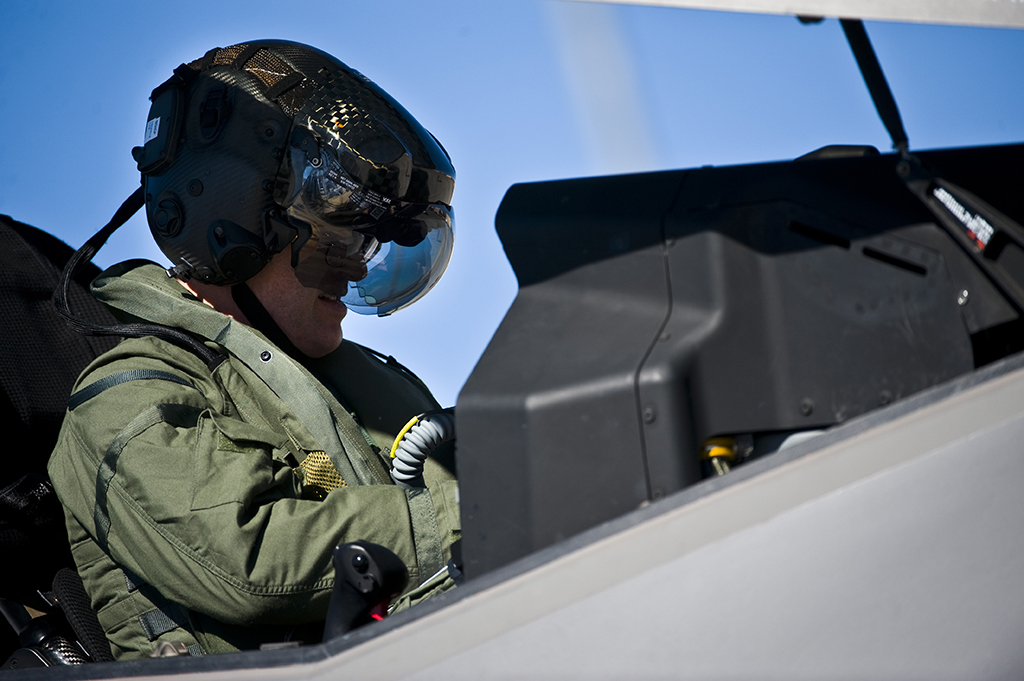“but I’m an old school pilot…”
Few months ago we published the interesting interview Maj. John Wilson, an F-35 pilot with 61th Fighter Squadron, gave to Christian Sundsdal of the Danish website focusing on military topics Krigeren, at Luke Air Force Base.
Answering one of the questions, Maj. Wilson clearly admitted that an A-10 Thunderbolt II will always be better in CAS than the F-35 because it was designed to perform that kind of mission.
Recently, Sundsdal has published the second part of the interview, that focused on the 400k USD Helmet Mounted Display System, that combines FLIR (Forward Looking Infra Red) and DAS (Distributed Aperture System) imaging, night vision and a virtual HUD (Head Up Display).
The HMDS provides the pilot a sort-of X-ray vision imagery: he can see through any surface, with the HUD symbology he needs to fly the plane and cue weapons that follow his head and get projected onto the visor through the line of sight imagery.
As already explained in a previous article, the HMDS has suffered issues though: jitter and latency (solved) along with problems with turbulence and buffeting, that can cause display issues (particularly dangerous when the JSF is maneuvering to evade an enemy missile shot), decreased night-vision acuity, and information sharing when 3 or 4 aircraft fly together.
Still, Wilson is probably not worried by such troubles since he doesn’t use the helmet very much:
“It’s cool, but I don’t use it that often” he says.
The reason is pretty simple: “If I really wanna see what’s underneath me, I’ll just look outside, I just roll up….because it doesn’t take much longer for me to just bank the airplane.”
Interesting point of view.
According to the F-35 pilot, he would just “look” as he would see in much higher clarity with his own eyes. Pilots consider it an “added benefit” and use it sometimes for night flying but that seems to be the only time when the costly HMDS is used (at least by Wilson and his 61th FS colleagues).
Still, Wilson admits he’s an old school pilot, so there may be pilots who use it more often.
“What about if you need to look behind you?” asks one of the interviewers.
Wilson is quite sure: “I’ll use my eyes” because “I need to see things with my own eyes” to judge aspect, distance closure, and other details that you can’t get using a 2D camera.
The F-16, with no camera, has a really good visibility: “It’s just a kind of apple to orange comparison,” Wilson explains, highlighting the fact that the F-35 and the F-16 or F-22 were designed for different roles.
“If you are flying correctly and the jet is doing what it is supposed to do, [enemy] guys should die well before they get behind you” Wilson comments, suggesting, once again, that the JSF’s survivability in air-to-air combat (even against some of the aircraft it is supposed to replace) is based on its BVR (Beyond Visual Range), stealth and SA (Situational Awareness) capabilities, rather than in its agility (initially touted by LM test pilots…).
Ok now it’s time to watch the interview by yourself:
Pilot talks about the helmet and visuality within the F-35 Joint Strike Fighter Lightning II from Krigeren.dk on Vimeo.
Top image credit: U.S. Air Force




















